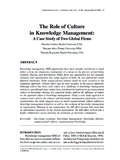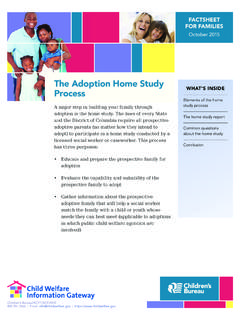Transcription of Compelling issues for adoption of e-health
1 The Commonwealth Health Ministers Reference Book 20081E-HealthCompelling issues for adoption of e-healthDr Roberto J Rodrigues, eHealthStrategies, USAI nformation and communication technologies (ICT) are leading to a progressive blossoming of automation in the health sector. This development of e-health is occurring not only in libraries, business offices and the management of assets, but also regarding patient administrative data, instrumentation and diagnostic equipment, departmental systems, and patient care, continuing a trend that began in the laboratory and spread to clinical care areas. The ubiquity of interactive communications and networks of producers, suppliers, customers, and clients has made possible novel applications oriented to the functional interconnection of professionals and the integration of clinical care processes.
2 These applications can achieve the efficient delivery of information and services, including remote monitoring and direct care, and endeavour to provide a response to many health sector needs. adoption of ICT, however, involves both optimistic and cautionary implications for the future of health practice. Determination of most appropriate implementation solutions demands a judicious approach to requirement analysis of each particular health system organisation and governance ICT solutions use internet-based technologies to rethink, redesign, and rework how businesses and public services operate. The essence of e-health , as in e-commerce, is reliable transaction delivery in a fast-changing environment involving people, processes, and an operational or business infrastructure.
3 Frequently, e-health is equated to telemedicine; however, the latter term should be more appropriately applied only to the use of ICT for remote clinical consultation, case review, and second applications address a range of healthcare challenges: Standardised information exchange and networking: information needs to flow between healthcare facilities, levels of care, and caregivers, assisting in forecasting demand and responding to it. Improvement in care-level links for consultation, logistics and quality assurance. Disconnection in care provision, the overlapping of responsibilities, and wasteful use of resources. A wide variety of expectations about greater access to healthcare and information, telehealth services, second opinion, communities of practice, evidence-based decision support, reduction of errors, consumer-oriented information, and health promotion.
4 The requirement for custom-built products and services (individualisation of care) and real-time delivery (to improve customer satisfaction). The growing need for professional continuing education and the bridging of the know-do gap . The need to keep evidence-based explicit knowledge up to health systems through ICT works for greater equity, solidarity, quality of life and health, and ultimately contributes to the goal of poverty reduction. This role is captured in the UN Millennium Development Goals Target 18: In co-operation with the private sector, make available the benefits of new technologies, especially information and communications. e-health addresses new healthcare trends by facilitating individual information capture, data mining, and concomitant access by multiple It promotes evidence-based decision making and continuity in the relationship between provider and client, and increases client participation.
5 In particular, it supports the partnering of providers, insurers and clients, and brings about transparency and co-operation among healthcare providers, breaking down the barriers between independent professional roles. The Commonwealth Health Ministers Reference Book 20082E-HealthChallengesMost existing health information systems are inadequate in terms of the new models being deployed in health reform initiatives. In addition, the health sector has not kept pace with the momentum experienced in recent years by other productive segments of society in embracing in developed countries, public and private applications have evolved in a patchy and inefficient way, with a limited number of standardised data-related definitions and processes supporting only a restricted number of operational requirements.
6 In order to reap the full benefit of ICT deployment in complex environments it is necessary to have a clear definition of goals and effective collaboration among stakeholders. This will lead to appropriate technology infrastructure, systems integration, and standards allowing rapid adaptation to changing technologies and continuous measurement of performance expectations have too often overshot their target overestimation of results and unfounded expectations are frequent pitfalls a common error being to regard technology by itself as an answer for the logistical, administrative, and knowledge management problems of healthcare. ICT development issuesOrganisational and governance enablersAt the governance level, there is a need for the understanding of infrastructure issues and agreement on needs and priorities.
7 Continuity of action must be coupled with the development of national policies and a regulatory framework aimed at the reduction of the impact of external factors, implementation of standards, and guidance of the organisational changes required for the deployment of ICT solutions. Strategies must be developed for the standardisation and cost-effective use of technology and information. Planning must also include the managerial issues and changes in work patterns and procedures which are inevitable, as is an increased documentation workload for staff and direct healthcare professionals. Other issues to be addressed include training, physical security and confidentiality of patient-related data. Human factors: awareness, skills, and leadershipPeople are central to the creation and use of e-health products and services.
8 Changes of strategies, structures, and form of service delivery must be accepted by direct care professionals they must adapt, learn new skills and competences and, above all, acquire and commit to new mindsets and attitudes. Required skills include computer and web technologies, as well as the organisational and managerial competences and leadership necessary for the changes in working methods and job roles. It has become necessary to understand the functional capabilities of e-health technologies, integrated patient management and electronic health records, epidemiological networks, and telecare; and to be aware of the associated legal, ethical, and economic issues . StandardisationThe automation of processes and services is not feasible without data standards that allow communication through open access internet-oriented software languages.
9 Core difficulties in setting these standards concern the low definition level of contents (deliverables), failure to determine the objectives and functionalities desired for applications, and conflicts in defining minimum data sets for operational management and clinical decision-making. Standards development and implementation is a slow process and may require concerted regulatory order to reap the full benefit of ICT deployment in complex environments it is necessary to have a clear definition of goals and effective collaboration among stakeholders. The Commonwealth Health Ministers Reference Book 20083E-HealthTechnology distribution, access, and utilisationThe multiple-step interactive processes of innovation and adoption require constantly changing resources and skills, involving a wide range of actors and interests operating under different goals, incentives, and timelines.
10 Those processes exhibit dead ends, feedback loops, multi-directional interactions, parallel developmental paths, and unintended innovation and adoption characterised by uncertainty, search, exploration, financial risk, experiment, and discovery take place in an established social and cultural environment. Besides issues of technology access, effectiveness, and appropriateness, there are questions related to the social, ethical, and economic impact of technological innovation, including class, educational, and cultural divides. In the wider electronic marketplaces, particularly in developing countries, areas of concern include: Difficulties in regulating offshore business The dominance of global communications by a few countries and corporations Market capture by strong, organised and well-funded health provider organisations, some of international nature.







